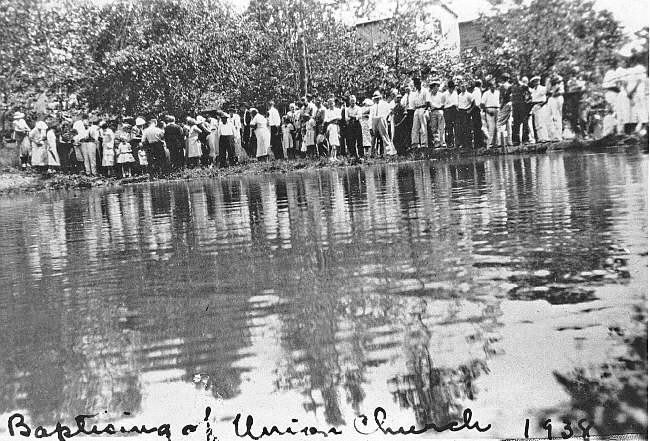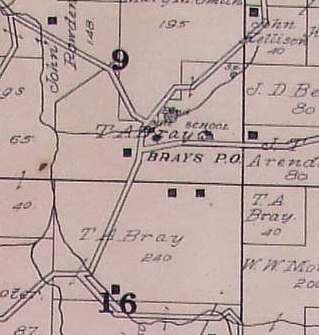
BRAYS/BRAYS MILL - A Century in the Big Richwoods
The Big Richwoods is a term given by early settlers to what is now the center of Miller County's largest township. Richwoods was named for the extraordinary timber found there. The Big Tavern Creek flows north, dividing the Big Richwoods in half. Flowing west into the Big Tavern is Bolin's Creek. On a hillside north of Bolin's Creek, Bray's Union Church was founded by neighborhood families during the last quarter of the nineteenth century. The church grew amidst a rural hamlet which had developed a thriving mill, general stores, a blacksmith shop, and school.
The community consisted largely of southern upland immigrants. Old families in the Bray's community migrated during the 1850's, 1870's, and 1880's. An industrial attraction east of Bray's, the Massey Iron Works at Meramec, was a focus of much pre-Civil War activity. People in the Osage-Gasconade region sought to bargain their services for a share of iron or wages. Many pioneer men became farmers or blacksmiths. The frontier demanded the smith-the first small industrial unit. He was a horse-farrier, fashioned tools, mended wagons, sharpened picks, tempered axes, and shrunk wagon tires. Iberia postmaster, Ruben Short, offered Massey's the service of a mason, miller, or sawyer early in 1843. Morrow immigrants from the Carolinas and northern Georgia obtained work in 1854 at Massey's. The following Spring they joined James Morrow in the Big Richwoods, and began farming.
Pennsylvanians also came to the Big Richwoods in the 1850's. William Irwin came and was pleased that he had found a place with good water and a healthy environment. He was astonished at the tall grass on the ridges, at thirty pound turkeys, and commented on the friendliness of neighbors who were "great for getting married at twelve and fifteen years of age." The house of many early settlers was the "dog-trot": two large rooms set apart from one another and connected by a roof. Rafter space was occupied by dried vegetables, bacon, skins and seed. Small scale milling was performed on many farms. Mills were built into a creek bank which could be fed small amounts of grain by hand for one family's use. Graham flour was made by mashing grain inside a large hollow stump with a club. By 1854 a water-powered mill was constructed at Bray's. This industry was the first permanent installation marking the beginning of Bray's hamlet.
The Civil War engulfed the Ozark region. Miller, Ripley, and other counties were depopulated. By 1870 Miller and Ripley were the only Missouri counties who had not regained their 1860 population figures. Violence in Miller County continued until 1874. Families remembered that the courthouse had been forbidden to abolitionist preachers while soldiers and bushwhackers had decimated stock, poultry, and ruined crops. But railroads in the 1870's began to diffuse modernization and immigration into the Ozark region.
Localism has been a profound force in the Ozarks. The Osage River dividing Miller County in half has intensified localism in Miller County. People on either side have referred to each other as "yond siders." In 1872 a railroad bond was offered to the public for a line running from Jefferson City-Tuscumbia-Lebanon. The line would have directly benefited western Miller County, but not Big Richwoods. Richwoods Township helped to soundly defeat the bond by voting 211-0 against it.
Richwoods Township was an agrarian society as families supported themselves on subsistence farms. The region remained "isolated" from major modernizing influences. Richwoods like most Ozark townships in the late nineteenth century experienced dramatic population growth. Almost ninety percent of the population was forty years of age or younger. In 1870 only two Richwoods residents were past eighty, and two families were headed by children, one aged twelve, and the other ten. This young populace saw their illiteracy rate climb higher than pre-Civil War rates, due to social institutions not keeping pace with population increase. Farming was still the major occupation, but the railroad tie industry, and lead, tiff, and iron surface mining, brought an increased cash economy.
The 1870's marked a particular beginning for Bray's Union Church. Although the exact first meeting of neighbors for Christian fellowship is not available, it surely pre-dated the 1870's. By the late 1870's fellowship meetings were held in neighbor's homes, and were regular enough to warrant consideration for a permanent building. In 1877 James Morrow sold to his nephew, William Wiley Morrow, eighty acres of land. Within this tract the future Bray's Union Church would be built. In 1885 Will Morrow sold seventy-nine acres of the above eighty to George "Mart" Humphrey, keeping one acre aside for a church site. In January 1887, the Christian school east of the church required the 1893 school year to be held in Union Church. After the school term in Union Church, a new Bray's school opened, offering "lickin' and larnin'".
Nearby in 1889 Tom Bray constructed a roller mill near the original water-powered grist mill. During harvest there was always a back-log of work for the mills. Overnight camping at the mill site was common as people slept under wagons and large bushes for protection from the falling dew and mosquitoes. About this time Will Morrow rebuilt the wooden water wheel, and helped in overhauling the older mill.

Bray's Mill, 1969
Preaching at Bray's Union Church was irregular for many years. Hannah Humphrey, Nellie Newhart, and Atha Ann Morrow encouraged a regular Sunday school, and George Shepherd taught a singing class. Religious experience in the Bray's neighborhood has changed with the passing of time. In the summer, brush arbors have been held at the St. Anthony "Y" and at Bray's spring; Baptists washed feet at the door of Union Church; fall tent revivals were held eat of the Union Church building; until the early twentieth century baptisms were performed in the now gravel-choked Bolin's creek just south of the church building; in later years the Big Tavern Creek was the scene of multiple baptisms; and the swimming pool behind Bray's mill also served as baptistery.

Bray's Baptising, 1938
The obituary for Hannah Humphrey was written by one of Union's early ministers, George DeBeer. Hannah was a charter member of the Advent Christian Church at Bray's "some thirty-five years" before her death in July 1913. Homes like the Humphrey's were the settings for neighborhood fellowship in the late 1870's and early 1880's. The Mart and Hannah Humphrey family was representative of the proverbial large family with numerous descendants. When Mart passed away in March, 1939, he left thirteen children, seventy-two grandchildren, and seventy great-grandchildren.
Union churches have been an historic phenomenon in the Ozarks. In rural neighborhoods that did not have a surplus of wealth, people cooperated in the construction of churches and maintenance of them. The mid-to-late twentieth century has been a time of general prosperity resulting in more discretionary money. People have tended to found and give their support to only one church. This has happened at Bray's Union Church as the Union Church concept has become a past tradition.

Sunday school picnic at Brays, 1938
BRAYS
By Kelly Warman-Stallings
The Ghost Towns of Central Missouri

Brays Community from 1904 Atlas
The settlement of Brays was begun in the 1840s when Larkin Osborne bought some acreage in eastern Miller County. Osborne (sometimes spelled Osbourn) was the first person to enter and record this land which was deeded as a land grant from the United States General Land Office (July 1, 1845). In 1848, Osborne sold most of the land that was located in Richwoods Township to Mesheck Rowden who was from McMinn County, Tennessee. When Rowden died four years later, his son, John Rowden, bought out Mechek's other heirs and in 1854, erected a water mill on the site which was used for grinding and crushing different grains. About 1862, the mill was sold to Thomas and Mahala Bray who owned and operated a woolen mill at Pay Down, a river town on the Gasconade River in Maries County.
During the Civil War years Bray hired Joe Slawson of Maries County to run the mill and later it was operated by Josh Stephens. In 1877, the Brays hired Albert and Helen Arendall to run the mill and the Arendall family moved from Pay Down to Miller County. It was about the same year, 1877, that the milling borough of Brays became known as a permanent settlement. A decade later, in 1889, Thomas Bray financed the construction of a roller mill and it was built close to the water mill. This roller mill accommodated surrounding settlements and the neighboring counties of Maries, Osage and Pulaski.
A grocery store and church was soon added to the community and in 1894, a post office was established as well. The mail was delivered from Hancock (Pulaski Co.), 12 miles due south of Brays, on the old Hancock Mail Route Road. The post office was discontinued in 1923. For many years the Arendalls ran the mill. Thomas Bray died in 1906 and his widow sold the mill to the Arendall family. They operated it until 1912 when they sold out to Arch and Charley Helton. For reasons unknown, the mill was sold back to Arendall a short time later and they continued operation until 1919 when they sold the land to their grandchildren, Guy, Mabel and Laura Smith.
In 1922, the Smith girls sold their share of the land to Guy. In 1929, Guy constructed an ice plant and his son, Isaac Smith, operated it until 1942. It was one of the last businesses in Brays. When the refrigerator was invented and more families acquired one for their homes, the ice plant went out of business.
At one time there was a school in the vicinity called Brays. The teacher in the 1930/31 school year was Willard Humphrey from Hancock. Brays began to die out in the 1940s after almost 100 years of existence. A pleasant history accompanies the forming of Brays and it is said that two U.S. Presidents (James Buchanan and U.S. Grant) even claimed ownership of Brays Mill at one time. All that remains of this fascinating little settlement is the old and decrepit grocery store, long ago abandoned to nature and its elements. The original roller mill still stands and has been converted into a private residence.
Regional Ancestral Names: Arendall, Bolien, Helton, Humphrey, Jones, Lair, Lankeman, Morrow, Osbourn/Osborne, Pendleton, Renfrow, Rowden, Skaggs, Slawson, Smith, Stephens, Warman, Whitaker, Winningham, Woody, Airhart/Ahart, Goforth, Kirkwood, Sherrell, Wilson.